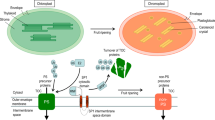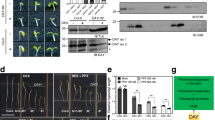Abstract
Iridoplasts (modified plastids in adaxial epidermal cells) reported from Begonia were originally hypothesized to cause iridescence, which was broadly accepted for decades. However, several species of Begonia with iridoplasts are not iridescent causing confusion. Here chloroplast ultrastructure was observed in 40 taxa of Begoniaceae to explore the phenomenon of iridescence. However, 22 Begonias and Hillebrandia were found to have iridoplasts, but only nine display visually iridescent blue to blue-green leaves. Unexpectedly, a new type of plastid, a ‘minichloroplast,’ was found in the abaxial epidermal cells of all taxa, but was present in adaxial epidermal cells only if iridoplasts were absent. Comparative ultrastructural study of iridoplasts and a shading experiment of selected taxa show that a taxon with iridoplasts does not inevitably have visual iridescence, but iridescence is greatly affected by the spacing between thylakoid lamellae (stoma spacing). Thus, we propose instead the name ‘lamelloplast’ for plastids filled entirely with regular lamellae to avoid prejudging their function. To evaluate photosynthetic performance, chlorophyll fluorescence (Fv/Fm) was measured separately from the chloroplasts in the adaxial epidermis and lower leaf tissues by using leaf dermal peels. Lamelloplasts and minichloroplasts have much lower photosynthetic efficiency than mesophyll chloroplasts. Nevertheless, photosynthetic proteins (psbA protein of PSII, RuBisCo and ATPase) were detected in both plastids as well as mesophyll chloroplasts in an immunogold labeling. Spectrometry revealed additional blue to blue-green peaks in visually iridescent leaves. Micro-spectrometry detected a blue peak from single blue spots in adaxial epidermal cells confirming that the color is derived from lamelloplasts. Presence of lamelloplasts or minichloroplasts is species specific and exclusive. High prevalence of lamelloplasts in Begoniaceae, including the basal clade Hillebrandia, highlights a unique evolutionary development. These new findings clarify the association between iridescence and lamelloplasts, and with implications for new directions in the study of plastid morphogenesis.






Similar content being viewed by others
References
Almeida AM, Santos M, Villalobos E et al (2007) Immunogold localization of trehalose-6-phosphate synthase in leaf segments of wild-type and transgenic tobacco plants expressing the AtTPS 1 gene from Arabidopsis thaliana. Protoplasma 230:41–49
Clement WL, Tebbitt MC, Forrest LL et al (2004) Phylogenetic position and biogeography of Hillebrandia sandwicensis (Begoniaceae): a rare Hawaiian relict. Am J Bot 91:905–917
de Wilde JJFE (2011) Begoniaceae. In: Kubitzki K (ed) The families and genera of vascular plants, vol 2. Springer, Berlin, pp 56–71
de Wilde JJFE, Plana V (2003) A new section of Begonia (Begoniaceae) from west central Africa. Edinb J Bot 60:121–130
Doorenbos JM, Sosef SM, de Wilde JJFE (1998) The sections of Begonia, including descriptions, keys and species lists (studies in Begoniaceae VI). Wageningen Agricultural University, Wageningen
Endler JA (1993) The color of light in forests and its implications. Ecol monogr 63:1–27
Federer CA, Tanner CB (1966) Spectral distribution of light in the forest. Ecology 47:555–560
Forrest LL, Hollingsworth PM (2003) A recircumscription of Begonia based on nuclear ribosomal sequences. Plant Syst Evol 241:193–211
Frodin DG (2004) History and concepts of big plant genera. Taxon 53:753–776
Gibbs SP (1960) The fine structure of Euglena gracilis with special reference to the chloroplasts and pyrenoids. J Ultrastruct Res 4:127–148
Glover BJ, Whitney HM (2010) Structural colour and iridescence in plants: the poorly studied relations of pigment colour. Ann Bot 105:505–511
Gould KS, Lee DW (1996) Physical and ultrastructural basis of blue leaf iridescence in four Malaysian understory plants. Am J Bot 83:45–50
Graham RM, Lee DW, Norstog K (1993) Physical and ultrastructural basis of blue leaf iridescence in two neotropical ferns. Am J Bot 80:198–203
Gu C, Peng CI, Turland NJ (2007) Begoniaceae. In: Wu ZY, Raven PH, Hong DY (eds) Flora of China, vol 13. Science Press, Beijing, Missouri Botanical Garden, St. Louis, pp 153–207
Jacobs M, Lopez-Garcia M, Phrathep OP et al (2016) Photonic multilayer structure of Begonia chloroplasts enhances photosynthetic efficiency. Nat Plants 2:161162
Jangoux J (2002) Begonia venosa in the Chapada Diamantina, Bahia, Brazil. Begonian 69. http://www.begonias.org/Articles/Vol69/Begonia_venosa.htm. Accessed 28 Feb 2017
Kiew R (2005) Begonias of Peninsular Malaysia. National History Publications, Kota Kinabalu (Borneo)
Lai KS (2008) Taiwan’s native begonias and environmental needs. Nat Conserv Q 63:24–30
Lee KB (2007) Structure and development of the upper haustorium in the parasitic flowering plant Cuscuta japonica (Convolvulaceae). Am J Bot 94:737–745
Nguyen QH, Tebbitt MC (2006) Begonia hahiepiana, a new species of Begonia Section Sphenanthera (Begoniaceae) from Vietnam. Novon 16:374–377
Pao SH (2012) A study on leaf structure, mechanism of foliar variegation and novel chloroplasts in Begoniaceae. Master thesis, National Chiayi University, Chiayi
Pyke K (2009) Plastid biology. Cambridge University Press, Cambridge
Sheue CR, Sarafis V, Liu HY et al (2004) Structural study on leaves of super shade plants. In: Proceedings of the 24th R. O. C. symposium on microscopy, 17th January. National Defense Medical Center, Taipei
Sheue CR, Sarafis V, Kiew R et al (2007) Bizonoplast, a unique chloroplast in the epidermal cells of microphylls in the shade plant Selaginella erythropus (Selaginellaceae). Am J Bot 94:1922–1929
Sheue CR, Pao SH, Chien LF et al (2012) Natural foliar variegation without cost? The case of Begonia. Ann Bot 109:1065–1074
Sheue CR, Liu JW, Ho JF et al (2015) A variation on chloroplast development: the bizonoplasts and photosynthetic efficiency in the deep-shade plant Selaginella erythropus. Am J Bot 102:500–511
Shui YM, Peng CI, Wu CY (2002) Synopsis of the Chinese species of Begonia (Begoniaceae), with a reappraisal of sectional delimitation. Bot Stud 43:313–327
Théry M (2001) Forest light and its influence on habitat selection. Plant Ecol 153:251–261
Thomas KR, Kolle M, Whitney HM et al (2010) Function of blue iridescence in tropical understorey plants. J Royal Soc Interface 7:1699–1707
Vignolini S, Moyrond E, Glover BJ, Steiner U (2013) Analysing photonic structures in plants. J Royal Soc Interface 10:20130394
Vogelmann TC (1993) Plant tissue optics. Annu Rev Plant Biol 44:231–251
Whitney HM, Kolle M, Andrew P et al (2009) Floral iridescence, produced by diffractive optics, acts as a cue for animal pollinators. Science 323:130–133
Wu YH (2012) Chloroplast diversity, bizonoplast development and immunogold labeling of photosynthetic protein of Selaginella erythropus. Master thesis, National Chiayi University, Chiayi
Zhang Y, Hayashi T, Hosokawa M, Yazawa S, Li Y (2009) Metallic lustre and the optical mechanism generated from the leaf surface of Begonia rex Putz. Sci Hortic Amsterdam 121:213–217
Acknowledgements
The authors thank the editor and three anonymous reviewers for valuable comments and suggestions. This article is dedicated to the memory of the late Dr. C. C. Tsai who did much to promote the study of plant phylogeny and structure. The authors thank Dr. W. H. Hu (The National Museum of Natural Science, Taichung) for providing the material of Hillebrandia, Miss P. C. Chaw (National Chung Hsing University) for assistance in TEM operation, and Mr. Lin (Meijia Company) for assistance in CSLM operation. This study was partially supported by the Ministry of Science and Technology [MOST-101-2621-B-005-002-MY3; MOST 104-2621-B-005-002-MY3], Taiwan.
Author information
Authors and Affiliations
Corresponding author
Additional information
Deceased: Chi-Chu Tsai, Ching-I Peng.
Dr. Ching-I Peng named 93 new species of Begonia, and is widely acknowledged for his contributions to Begonia research.
Electronic supplementary material
Below is the link to the electronic supplementary material.
Rights and permissions
About this article
Cite this article
Pao, SH., Tsai, PY., Peng, CI. et al. Lamelloplasts and minichloroplasts in Begoniaceae: iridescence and photosynthetic functioning. J Plant Res 131, 655–670 (2018). https://doi.org/10.1007/s10265-018-1020-2
Received:
Accepted:
Published:
Issue Date:
DOI: https://doi.org/10.1007/s10265-018-1020-2




